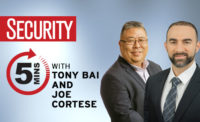5 minutes with Dr. Tommy Gardner - How to accelerate U.S. supply chain and security innovation

Dr. Tommy Gardner, Chief Technology Officer of HP Federal, believes a proactive mindset that bridges the digital divide, recruits top talent and implements the right policies is needed for the U.S. to achieve success and remain competitive on a global scale. Here, he discusses how a national strategy for critical technologies can shape the industries of the future as well as address national security and global challenges.
Security: What is your background, current role and responsibilities?
Dr. Gardner: Many years ago, I served in the U.S. Navy as the deputy for science and technology for the chief of naval research and oversaw the Navy’s Deep Submergence Program and its Advanced Technology Program. I also commanded the nuclear submarine, USS San Juan (SSN 751). When the time came for me to start thinking about life after the Navy, another submariner who I met at the Naval academy gave me some advice I never forgot. He told me that there would be many jobs out there and many I’d want to take, but he said I should never settle for a job at a company that didn’t have values and ethics I respected. That lesson eventually led me to HP, a company I have been very proud to work for and whose mission I strongly believe in.
In my role as the Chief Technology Officer of HP Federal, I wear many hats. I help our customers across state, local and federal agencies transform their organizations with the right solutions, products and tech strategies. I help ensure that HP’s technology offers state-of-the-art security and that we are constantly innovating in the fields of data science, quantum computing and more. I’m also proud to serve alongside my peers in both the public and private sectors on taskforces to evolve how we view risk assessment, supply chain management and cybersecurity.
Security: How can the U.S. accelerate supply chain and security innovation in light of recent supply chain attacks?
Dr. Gardner: The message every organization should take from these attacks is, of course, to act now. No entity is immune to these threats, and everyone should be shoring up their security protocols. Now more than ever, it is critical for all U.S. vendors to develop advanced ICT supply chain security plans to protect citizens and government partners. To accelerate supply chain processes and enhance security efforts, government agencies need better visibility into the security strategies that their vendors implement. Having transparency into how technology is being developed, integrated and deployed can help organizations identify risks and threats sooner and establish stronger integrations throughout a supply chain.
A vulnerability I see often occurs in the reseller system during the “last mile” of the ICT supply chain. As a way to prevent potential hacks or disruption, agencies should conduct an internal audit of their prime vendors to determine the potential exposure of risks and evaluate where improvements are needed. Security investments and consistent evaluations of threat-based ICT supplies can help make supply chains more resilient while preventing future hacks. All long-term business must be based on trust. Companies must spend the time, energy and resources necessary to get to know their vendors and suppliers in order to trust them. Build relationships for a robust supply chain.
Security: How can U.S. leaders deploy a national strategy for critical technologies that will shape the industries of the future and address national security and global challenges?
Dr. Gardner: Leaders at all levels of federal and local government should see an opportunity in adopting standards that encourage technology innovation while also addressing security challenges. Devoting resources to creating and deploying standards that address interoperability, privacy and usability can help the nation focus on future-proofing digital capabilities and modernizing sustainable initiatives for the future. The private sector must work with the government to adopt a federally mandated to-do list that outlines strategic actions and targeted outcomes for companies to follow and achieve. We are on the right path. Ultimately, enterprises that collectively operate around shared standards can address vulnerabilities early on, have more secure partnerships with different entities, and more easily identify improvements that can be made to their security protocols. The implementation of innovative standards is an imperative and a clear advantage for leaders in the public and private sectors.
Security: How can U.S. leaders expand the nation’s talent pool as a critical element of the federal government’s evolving role and responsibilities?
Dr. Gardner: Federal and local government leaders have the amazing privilege and responsibility of developing the tech workers of the future, including those who will be experts in rapidly evolving areas like cybersecurity, digital manufacturing and IT. We need to train new tech workers from the ground up and invest in the current workforce who already have foundational technology skills and experience. I am a strong advocate for reskilling veterans and federal workers through training and certification programs that help close the talent gap and create a pipeline for further innovation. Community Colleges can play a role here.
Higher education leaders play a key role in educating the future federal workforce. In collaboration with federal and government agencies, universities and colleges can introduce technical education to students earlier on so they become more familiar with the industry and acquire basic technical knowledge that will serve anyone on any career path today. Perhaps a factor in federal grant can be the number of graduates from the university that enter the federal workplace?
Security: Lastly, how can U.S. leaders promote sustainable production/consumption against a backdrop of supply chain resiliency and security?
Dr. Gardner: Prioritizing sustainability is imperative. Every organization must build it into its operating models and invest in it. It is critical for our nation’s leaders to address digital equity when updating security protocols and promoting sustainable initiatives. If sustainability is not at the core of current innovation, we should address it in the next round. From supply chains to online voting systems to telehealth portals and tax collection structures, our systems need technology that puts people, communities, and our planet’s health at the heart of the design. Operating with these tenets will ultimately reduce cybersecurity vulnerabilities and ensure resiliency throughout global supply chains. HP is committed to achieving ambitious sustainable impact targets, including initiatives to advance digital equity and enable better learning outcomes for 150 million people by 2030.
Looking for a reprint of this article?
From high-res PDFs to custom plaques, order your copy today!





